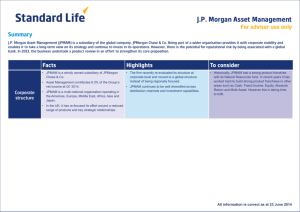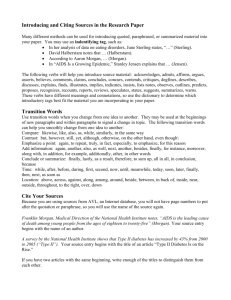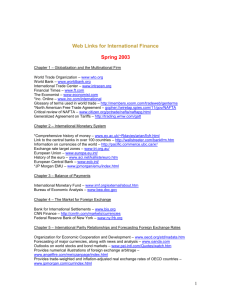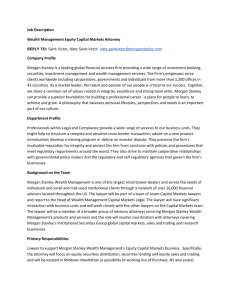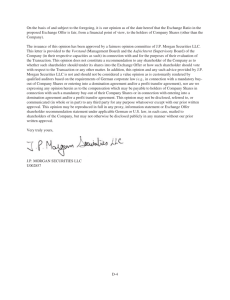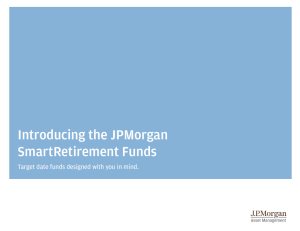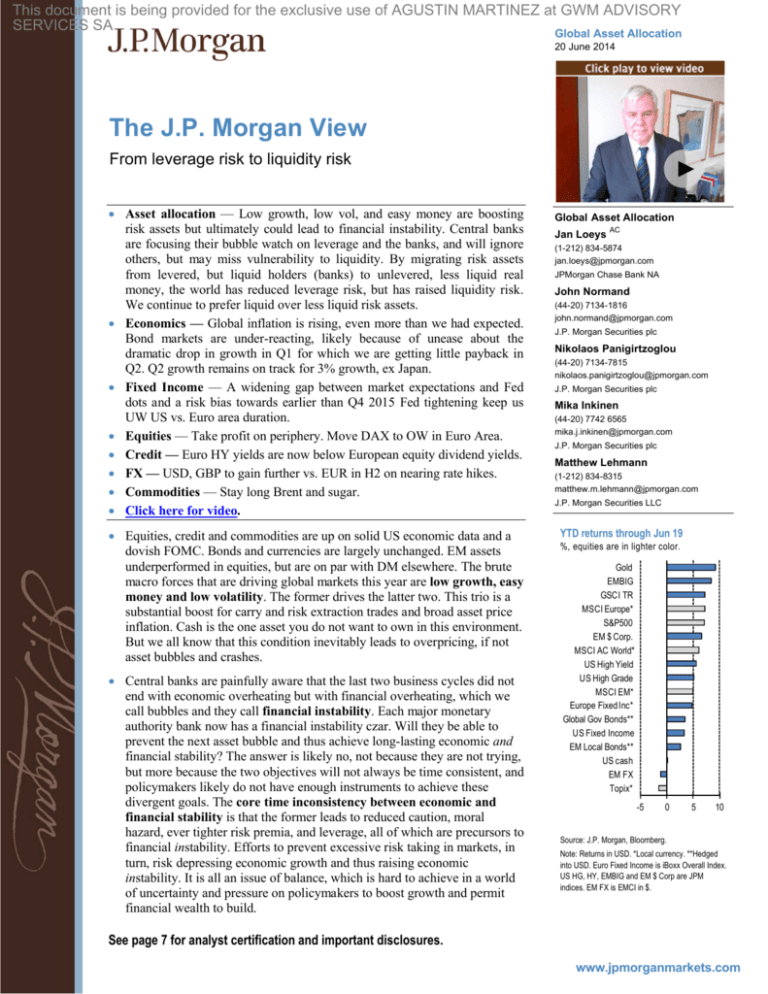
This document is being provided for the exclusive use of AGUSTIN MARTINEZ at GWM ADVISORY
SERVICES SA
Global Asset Allocation
20 June 2014
The J.P. Morgan View
From leverage risk to liquidity risk
Asset allocation –– Low growth, low vol, and easy money are boosting
risk assets but ultimately could lead to financial instability. Central banks
are focusing their bubble watch on leverage and the banks, and will ignore
others, but may miss vulnerability to liquidity. By migrating risk assets
from levered, but liquid holders (banks) to unlevered, less liquid real
money, the world has reduced leverage risk, but has raised liquidity risk.
We continue to prefer liquid over less liquid risk assets.
Economics –– Global inflation is rising, even more than we had expected.
Bond markets are under-reacting, likely because of unease about the
dramatic drop in growth in Q1 for which we are getting little payback in
Q2. Q2 growth remains on track for 3% growth, ex Japan.
Fixed Income –– A widening gap between market expectations and Fed
dots and a risk bias towards earlier than Q4 2015 Fed tightening keep us
UW US vs. Euro area duration.
Equities –– Take profit on periphery. Move DAX to OW in Euro Area.
Credit –– Euro HY yields are now below European equity dividend yields.
FX –– USD, GBP to gain further vs. EUR in H2 on nearing rate hikes.
Commodities –– Stay long Brent and sugar.
Click here for video.
Equities, credit and commodities are up on solid US economic data and a
dovish FOMC. Bonds and currencies are largely unchanged. EM assets
underperformed in equities, but are on par with DM elsewhere. The brute
macro forces that are driving global markets this year are low growth, easy
money and low volatility. The former drives the latter two. This trio is a
substantial boost for carry and risk extraction trades and broad asset price
inflation. Cash is the one asset you do not want to own in this environment.
But we all know that this condition inevitably leads to overpricing, if not
asset bubbles and crashes.
Central banks are painfully aware that the last two business cycles did not
end with economic overheating but with financial overheating, which we
call bubbles and they call financial instability. Each major monetary
authority bank now has a financial instability czar. Will they be able to
prevent the next asset bubble and thus achieve long-lasting economic and
financial stability? The answer is likely no, not because they are not trying,
but more because the two objectives will not always be time consistent, and
policymakers likely do not have enough instruments to achieve these
divergent goals. The core time inconsistency between economic and
financial stability is that the former leads to reduced caution, moral
hazard, ever tighter risk premia, and leverage, all of which are precursors to
financial instability. Efforts to prevent excessive risk taking in markets, in
turn, risk depressing economic growth and thus raising economic
instability. It is all an issue of balance, which is hard to achieve in a world
of uncertainty and pressure on policymakers to boost growth and permit
financial wealth to build.
Global Asset Allocation
Jan Loeys
AC
(1-212) 834-5874
jan.loeys@jpmorgan.com
JPMorgan Chase Bank NA
John Normand
(44-20) 7134-1816
john.normand@jpmorgan.com
J.P. Morgan Securities plc
Nikolaos Panigirtzoglou
(44-20) 7134-7815
nikolaos.panigirtzoglou@jpmorgan.com
J.P. Morgan Securities plc
Mika Inkinen
(44-20) 7742 6565
mika.j.inkinen@jpmorgan.com
J.P. Morgan Securities plc
Matthew Lehmann
(1-212) 834-8315
matthew.m.lehmann@jpmorgan.com
J.P. Morgan Securities LLC
YTD returns through Jun 19
%, equities are in lighter color.
Gold
EMBIG
GSCI TR
MSCI Europe*
S&P500
EM $ Corp.
MSCI AC World*
US High Yield
US High Grade
MSCI EM*
Europe Fixed Inc*
Global Gov Bonds**
US Fixed Income
EM Local Bonds**
US cash
EM FX
Topix*
-5
0
5
10
Source: J.P. Morgan, Bloomberg.
Note: Returns in USD. *Local currency. **Hedged
into USD. Euro Fixed Income is iBoxx Overall Index.
US HG, HY, EMBIG and EM $ Corp are JPM
indices. EM FX is EMCI in $.
See page 7 for analyst certification and important disclosures.
www.jpmorganmarkets.com
This document is being provided for the exclusive use of AGUSTIN MARTINEZ at GWM ADVISORY
SERVICES SA
Jan Loeys
(1-212) 834-5874
jan.loeys@jpmorgan.com
Global Asset Allocation
The J.P. Morgan View
20 June 2014
Most central banks are trying to maintain both economic and financial
stability by assigning monetary policy to the former and what they call
macro-prudential measures to the latter. In their view, which we share,
central banks cannot, and should not, prevent all asset bubbles. They should
only focus on those that threaten economic stability. That means, bubbles
need to be large and/or have serious contagion risk. In their mind, this means
anything large involving the banks or raising overall leverage in the financial
system. Banks are leveraged, impact all sectors of the economy, and are thus
the “ideal” contagion factor that central banks seek to control. Asset booms
and busts that do not involve aggregate leverage or the banks are likely to be
ignored by policymakers. And such busts have already taken place in this
cycle: witness the doubling in gold prices 2009-11, followed by a 30%
correction since. Policymakers ignored it and so did the economy.
One asset class boom that is much larger than gold, has much greater impact
on the economy, and is increasingly on “bubble focus” is the corporate bond
market. As an asset class, credit has grown much faster than equities and is
priced at much tighter risk premia, which are at cycle lows now (see also
today’s Flows & Liquidity). Policymakers are relatively sanguine on this asset
boom as they believe the asset class is largely owned by unleveraged investors
and thus has little risk of contagion. A sudden rise in US short rates could
easily entice fast outflows from higher yielding bond funds. If this pushes HY
bond prices down by say 10%, then that should be it: no forced selling or
contagion, as the holder is for the most part not leveraged, and the fund
manager’s capital is not affected. DB pension plans will actually see their
surplus rise as their liabilities fall faster as they are discounted by a bond
yield.
There is a risk scenario of a worse outcome that is getting increasing
attention by risk managers. By moving risk assets from banks to unlevered
real money, regulators have reduced the risk of forced selling when levered
holders run out of capital. But they have also increased the risk of liquidity
problems because in a crisis, investors move back into cash, which means
bank deposits. Given the reduced ability of banks to use their balance sheets to
buy risk assets during a fire sale, there is now a higher risk, in this analyst’s
mind, that when the Fed starts hiking in earnest, outflows from high-yielding
and less liquid debt will lead to a free fall in prices. In extremis, this could
force a closing of the primary market and have serious economic impact.
Some investors, and we in our model portfolio, are preparing by trimming
gradually our credit longs in favor of more liquid risk assets, in particular
equities. We have also moved more risk into commodity carry and EM. We
continue to find that a medium-term bearish option on the short end of the US
yield curve is the most direct way to hedge against this event risk.
Gold price since 2008
$/troy oz
2000
1800
1600
1400
1200
1000
800
600
Jun-08
Sep-09
Dec-10 Mar-12
Jun-13
Source: Bloomberg
Growth in asset classes 12/2008 – 05/2014
Ratio in market value of outstandings current over end
2008. CEMBI is emerging markets USD denominated
corporate debt. EMBI is emerging market USD
denominated sovereign debt. GBI-EM is emerging
market local debt. GBI global is developed market
government debt.
Fixed income ETFs
CEMBI
US HY
EMBI
US HG
GBI-EM
Global equities
GBI Global
1.0
2.0
3.0
4.0
5.0
6.0
Source: Bloomberg, J.P. Morgan, Datastream
Fixed Income
The outcome of the FOMC meeting this week was largely as expected.
The taper continued with another $10bn reduction in the monthly pace of asset
purchases to $35bn; the FOMC statement was little changed; the changes in
the interest rate forecasts were in line with our expectations; and Fed Chair
Yellen’s press conference indicated no urgency to step back from her highly
accommodative monetary policy. We thus continue to expect a first rate hike
in Q4 2015, with risks tilted toward an earlier move (see The future’s
uncertain and the end is always near, Michael Feroli, Jun 18).
What does this mean for our strategy? As a result of the rise in FOMC interest
rate projections, the market-based expectations of policy rates are now even
more below the Fed’s own policy rate forecasts (Chart p. 3). Combined with a
2
More details in ...
Global Data Watch, Bruce Kasman, David Hensley and
Joe Lupton
Global Markets Outlook and Strategy, Jan Loeys et al.
US Fixed Income Markets, Matt Jozoff, and Alex Roever
Global Fixed Income Markets, Fabio Bassi et al.
Emerging Markets Outlook and Strategy, Luis Oganes
and Holly Huffman
Key trades and risk: Emerging Market Equity Strategy,
Adrian Mowat et al.
European Equity Strategy, Mislav Matejka., et al.
Flows & Liquidity, Nikos Panigirtzoglou et al.
This document is being provided for the exclusive use of AGUSTIN MARTINEZ at GWM ADVISORY
SERVICES SA
Jan Loeys
(1-212) 834-5874
jan.loeys@jpmorgan.com
Global Asset Allocation
The J.P. Morgan View
20 June 2014
risk bias towards earlier than Q4 2015 tightening, this keeps us bearish on US
duration via an underweight in 5Y US Treasuries against German Bunds.
The BoE minutes for the June MPC meeting were released this week, but
contained few surprises after Governor Carney’s hints at earlier rate rises last
week. We continue to expect at least one member to dissent in favor of higher
rates by the August meeting, and the rest of the MPC sounding more hawkish
as well (June MPC minutes reveal a more subtle change in rhetoric, Allan
Monks, Jun 18). Stay underweight 5Y UK Gilts vs. Bunds).
Equities
MSCI AC World reached yet another historical high this week, led by US and
Japanese equities. Within EM, Asian equities in China and India in particular
underperformed their Latam counterparts, Brazil and Mexico.
The rally in peripheral equities has somewhat faded over the past few
months. The loss in momentum coupled with overstretched valuations has
prompted our European equity strategist (Mislav Matejka) to take profit on his
peripheral equity overweight vs. Germany trade.
Further, we believe that the risk reward for DAX has improved and now
recommend going long DAX relative to Eurostoxx50. Not only have DAX
earnings revisions turned positive, the index is now trading amongst the
lowest P/E multiples across the Euro area countries. The DAX is also a global
cycle play with 57% of the market cap weight in cyclical sectors on which we
are bullish. And it is more exposed to a pick up in activity in EM where we
are more positive. A decline of the euro to 1.30EUR/USD by year-end, as
projected by our FX team, should help export biased DAX companies.
Overall, euro area equities appear more attractively valued than their UK
counterparts (currently trading at a 5% P/Book discount to the 10-year
median). Our strategists note that the Euro area is also more “Value”
weighted than the UK, which fits our style preference for Value (see Trade
opportunities for long term investors, Jun 19). Other long-term value themes
we find attractive are overweighting EM vs. DM equities, Russia within
EM, and small caps in the US and UK vs. their Euro area counterparts.
Credit
Credit spreads were broadly tighter this week, led once again by US HY.
Our US HG credit strategists have now lowered their year-end spread forecast
for the JULI index from 120bp to 110bp. Currently, HG spreads are at 123bp.
Lower supply, falling EM risk and improving growth expectations, as well as
still strong demand for spread product should support credit through the
second half of the year (CMOS, Eric Beinstein et al.,). We keep our credit
portfolio focused on high yield and emerging markets, where we think there is
more upside. Within HG, we stay long financials, especially in Europe.
Euro HY continued to rally this week, with yields falling 6bp to a new record
low of 3.61%, and spreads tightening 3bp to 309bp. We continue to prefer US
HY, where yields and spreads are 5.5% and 413bp, respectively, with the
same 1% default rate expectations for this year. We took profit on our OW of
Euro HY at the beginning of the month as credit metrics were worsening and
yields had reached very low levels. Thus, the risk return tradeoff was looking
poor. Next year’s expected dividend yield on the Eurostoxx50 is now above
the Euro HY yield-to-worst for the first time since we have data in 2004.
Additionally, with spreads and yields so low, equities likely have significantly
more upside in terms of capital appreciation than credit (European High Yield
Market Update and Commentary, Matthew Bailey et al.).
FOMC Fed funds target rate projections and OIS
rates
Trimmed mean* of FOMC Fed funds target rate forecasts
for 2015 and 2016 plotted vs. 1-month OIS rates out of
15 Dec start date for each year; %.
3.00
2.50
2.00
FOMC Mar
OIS (19 Jun 14)
1.50
1.00
2.58
2.33
FOMC Jun
0.98
1.82
1.13
0.78
0.50
0.00
2015
2016
Source: Federal Reserve, J.P. Morgan
* Excludes 3 highest and lowest projections in the Summary of
Economic Projections.
Euro HY yields vs. Eurostoxx50 dividend yield
%. iboxx Euro HY yield-to-worst and Eurostoxx50 the
next year’s expected dividend yield from Bloomberg.
25
20
iBoxx Euro HY yield-to-worst
15
10
5
Eurostoxx50 12M forward dividend yield
0
May-05 Feb-07 Nov-08 Aug-10 May-12 Feb-14
Source: Bloomberg, iBoxx, J.P. Morgan.
More details in ...
US Credit Markets Outlook and Strategy, Eric Beinstein
et al.
EM Corporate Weekly Monitor, Yang-Myung Hong et al.
High Yield Credit Markets Weekly, Peter Acciavatti et al.
European Credit Outlook & Strategy, Stephen Dulake et
al.
Emerging Markets Cross Product Strategy Weekly, Eric
Beinstein et al.
3
This document is being provided for the exclusive use of AGUSTIN MARTINEZ at GWM ADVISORY
SERVICES SA
Jan Loeys
(1-212) 834-5874
jan.loeys@jpmorgan.com
Global Asset Allocation
The J.P. Morgan View
20 June 2014
Foreign Exchange
The dollar index is ending the first half of 2014 very close to where it started
the year (JPMQUSD), having declined vs. about as many currencies as it
advanced. Frustrating as that pattern has been for forecasters and traders, such
oscillations are nonetheless typical in the year or two leading up to Fed
tightening, when the dollar is passing through that awkward phase between
the reality of being a low-yielder now and the hope of being a high-yielder
later. Hence our preference for tame forecasts and mostly short-term trades
this year – it was too early in the Fed cycle to have great expectations for FX.
Even controlling for the lessons of history, however, the first half of 2014 has
been a shocker on several levels, like its record-low FX volatility, multiyear lows in FX trading volumes and below-average alpha generation for
FX funds as well as for JPM’s paper portfolio. It is often said that these
patterns reflect the hazards of holding consensus trades, the distortions from
massive central bank asset purchase programs and (relatedly) the decoupling
of markets from fundamentals. These claims are only half-true. Some FX
consensus trades entering 2013 actually delivered, such as bullishness on
GBP, NOK, NZD, KRW, MXN, and bearishness on CAD, SEK and RUB.
Model-driven FX strategies like carry and rate momentum are posting their
best performance in three years.
Weekly FX returns
% vs. the USD..
1.2%
1.0%
0.8%
0.6%
0.4%
0.2%
0.0%
-0.2%
-0.4%
-0.6%
USD JPY EUR GBP CHF CAD AUD
TWI
Source: Bloomberg
The second half of 2014 will probably be similar for its illiquidity and
lack of much momentum in the USD index, but different for the rank order
of currency performance and the end-December level of volatility. In terms of
reversals, H1 winners like JPY, NZD, NOK, TRY and BRL will probably
weaken in H2, while H1 losers like CNY should appreciate into year end. In
terms of trend extensions, expect further losses for EUR and ZAR, and further
gains for GBP and KRW. Vol should reverse higher to about 7% on VXY by
December, with the Fed a more likely driver than geopolitics. National
politics, however, become focal for the UK in September (Scottish
referendum), Brazil in October (Presidential election) and US in November
(Congressional election), but the first two are more material events for
currencies than the last one.
Commodities
Commodities rallied again this week, with all sectors higher. We doubled
our long in Brent last week on the risk of a supply disruption in Iraq. Since
then, the situation in Iraq appears little changed and we still view the risk of a
material production outage as higher than currently priced into the market.
The current focus is on whether ISIS attacks Baghdad but it is equally
possible that they turn south and attempt to undermine the Iraqi government
by interfering with oil production rather than making a direct assault on
Baghdad (Oil Pathfinder, Colin Fenton et al.,). We make no attempt to
forecast what happens next in Iraq, but we think it prudent to maintain our
long in Brent as a hedge to our long risk positions in equities.
We have been long sugar for a couple months now on the risks posed
from a likely El Niño this summer. In the past, El Niño has disrupted the
Indian monsoon and negatively affected sugar production there. In addition,
the recent drought in Brazil has worsened and spread into Sao Paolo, the key
sugar producing state. Expectations are now for the drought to subside and
rain to be more normal, but there is still considerable uncertainty regarding the
damage already done to crops. Sao Paolo accounts for 90% of Brazil’s sugar
production. We remain long the Mar-15 sugar contract.
4
More details in ...
FX Markets Weekly, John Normand et al.
Commodity Markets Outlook & Strategy,
Colin Fenton et al.
Oil Markets Monthly, Colin Fenton et al.
Natural Gas Weekly, Scott Speaker and Shikha
Chaturvedi
Metals Monthly, Natasha Kaneva et al.
Agriculture Weekly, Conor O'Malley
This document is being provided for the exclusive use of AGUSTIN MARTINEZ at GWM ADVISORY
SERVICES SA
Global Asset Allocation
The J.P. Morgan View
20 June 2014
Jan Loeys
(1-212) 834-5874
jan.loeys@jpmorgan.com
Forecasts & Strategy
Interest rates
United States
Fed funds rate
10-year yields
Euro area
Refi rate
10-year yields
United Kingdom
Repo rate
10-year yields
Japan
Overnight call rate
10-year yields
Emerging markets GBI-EM - Yield
Current
Sep-14
Dec-14
Mar-15
Jun-15
0.125
2.62
0.15
1.34
0.50
2.76
0.05
0.58
6.55
0.125
3.00
0.10
1.45
0.50
3.05
0.05
0.55
0.125
3.20
0.10
1.65
0.50
3.30
0.05
0.60
7.50
0.125
3.30
0.10
1.75
0.75
3.45
0.05
0.65
0.125
3.40
0.10
1.85
1.00
3.55
0.05
0.70
Credit Markets
US high grade (bp over UST)
Euro high grade (asset swap sprd)
USD high yield (bp vs. UST)
Euro high yield (bp over Bunds)
EMBIG (bp vs. UST)
EM Corporates (bp vs. UST)
123
89
412
325
279
331
Commodities
Brent ($/bbl)
Gold ($/oz)
Copper ($/metric ton)
YTD Equity Sector Performance*
Energy
Materials
Industrials
Discretionary
Staples
Healthcare
Financials
Information Tech.
Telecommunications
Utilities
Overall
1.36
102
1.70
0.94
2.23
6.15
1020
2.14
1.34
102
1.71
0.92
2.30
6.20
1000
2.15
Current
14Q3
115
1315
6734
105
1260
6750
US
12.9%
7.9%
5.4%
0.0%
6.9%
9.4%
5.0%
8.3%
4.9%
17.2%
7.2%
Europe
12.6%
6.0%
3.2%
4.4%
6.3%
11.6%
4.8%
-0.5%
3.3%
19.0%
7.2%
1.30
106
1.67
0.91
2.40
6.15
1000
2.15
1.30
107
1.68
0.90
2.45
6.15
995
2.15
Quarterly Averages
14Q4
15Q1
105
1285
6950
UW
N
N
N
UW
N
OW
OW
UW
OW
Japan
12.3%
-4.5%
1.7%
-6.0%
6.2%
2.0%
-9.9%
2.6%
-3.7%
-5.2%
-1.5%
Low growth means money stays easy
The current US recovery is the slowest since
WWII. Global growth will likely barely exceed
potential. Easy money stays for a long time.
Low macro vol drives carry trades
ZIRP and low macro vol make earning risk
premia and carry very attractive
Reduce tired carry; increase fresh carry
Credit spreads are near past cycle lows. We
see better carry/vol in commodity roll and EM.
OW EM across asset classes
EM growth is still trending down, but so is EM
risk. Adding in low global vol and underweight
EM positions made us OW EM in bonds, credit,
FX and stocks vs. DM.
110
80
425
365
300
325
Foreign Exchange
EUR/USD
USD/JPY
GBP/USD
AUD/USD
USD/BRL
USD/CNY
USD/KRW
USD/TRY
Investment themes and impacts
1.28
107
1.66
0.91
2.50
6.15
985
2.15
Watch out for fast-growing asset classes
Super easy money will ultimately produce
bubbles. The tell-tale sign is fast growth in
asset class size. Bond ETFs and HY are
growing fastest.
Past half-time in the global business cycle
June marks the 5th anniversary of the recovery.
Working hypothesis is 8-year recovery. That
keeps equity rally on track, but makes the credit
rally mature.
Source: J.P. Morgan, GMOS, Jun 4, 2014
Tactical overview
15Q2
Direction
103
UW
UW
OW
OW
OW
UW
OW
UW
OW
UW
EM$
6.2%
-0.5%
4.0%
6.7%
2.3%
7.2%
5.8%
13.4%
-0.4%
12.7%
6.1%
UW
UW
OW
N
UW
N
N
OW
UW
N
Country
Sector
OW Equities, HY
vs bonds, cash,
com’s
Asset
allocation
Bullish risk. EM
Equities
Long
Bonds
EU vs.
Flat
US & UK.
Duration in OW
DM; long Spain,
in EM
Italy; NZ;
Brazil
Credit
Reduce
OW
FX
Bullish
USD.
Carry
from INR, Long NOK, JPY;
short NZD
KRW,
COP
Neutral
Brent on carry;
Copper on better
demand from
China .
*Levels/returns as of Jun 19, 2014
Cyclicals, EM Asia,
Italy, EU Banks. J-
REITs
Source: J.P. Morgan
Comd’s
EM
HY, FINs,
NEXGEM.
Source: J.P. Morgan
5
This document is being provided for the exclusive use of AGUSTIN MARTINEZ at GWM ADVISORY
SERVICES SA
Global Asset Allocation
The J.P. Morgan View
20 June 2014
Jan Loeys
(1-212) 834-5874
jan.loeys@jpmorgan.com
Global Economic Outlook Summary
Real GDP
Real GDP
% over a year ago
% over previous period, saar
2013
2014
2015
4Q13
1Q14
2Q14
3Q14
Consumer prices
% over a year ago
4Q14
1Q15
4Q13
2Q14
4Q14
4Q15
United States
Canada
Latin America
Argentina
Brazil
Chile
Colombia
Ecuador
Mexico
Peru
Uruguay
Venezuela
1.9
2.0
2.5
3.0
2.5
4.1
4.7
4.5
1.1
5.8
4.7
1.3
2.0
2.2
1.6
-1.5
1.1
2.5
5.0
3.3
2.9
4.2
3.0
-1.0
2.9
2.6
2.9
3.0
1.8
3.5
4.5
4.0
3.8
5.5
4.0
2.5
2.6
2.7
1.5
-1.7
1.8
-0.4
3.5
4.7
0.5
6.9
6.4
2.3
-1.0
1.2
0.4
-4.5
0.7
3.0
9.9
2.0
1.1
0.3
-1.8
-8.5
3.0
2.2
1.4
-0.8
0.3
1.7
2.0
1.5
4.0
3.5
2.5
0.0
3.0
2.5
2.1
-4.6
1.6
4.0
4.0
2.0
3.9
6.0
3.0
2.5
3.0
2.7
2.8
-1.4
2.7
2.8
4.0
2.5
3.7
7.0
3.0
2.0
3.0
2.8
3.1
4.0
2.2
3.2
5.0
3.5
3.6
5.5
4.5
2.5
1.2
0.9
4.5
10.7
5.8
2.5
1.8
2.3
3.7
3.0
8.6
52.9
2.1
1.7
5.0
34.0
6.3
4.5
2.8
2.0
3.7
3.2
8.1
57.2
2.4
1.9
5.1
40.0
6.3
4.3
3.2
3.2
4.1
3.0
7.8
58.2
1.9
2.1
4.7
45.0
6.3
3.0
3.0
4.0
3.1
2.5
7.3
35.0
Asia/Pacific
Japan
Australia
New Zealand
EM Asia
China
India
EM Asia ex China/India
Hong Kong
Indonesia
Korea
Malaysia
Philippines
Singapore
Taiwan
Thailand
4.6
1.5
2.4
2.8
6.2
7.7
4.7
4.0
2.9
5.8
3.0
4.7
7.2
3.9
2.1
2.9
4.5
1.4
3.0
3.2
6.1
7.2
5.3
4.0
2.8
4.9
3.8
5.5
6.0
4.4
3.5
1.1
4.8
1.5
3.2
2.8
6.4
7.2
6.5
4.6
2.6
5.7
4.0
5.1
6.4
5.0
3.8
4.2
4.5
0.3
3.2
4.1
6.4
7.6
4.2
5.1
3.6
6.0
3.6
7.6
6.1
6.9
7.6
0.5
5.3
6.7
4.5
4.0
4.8
5.9
5.0
2.3
0.8
4.1
3.8
3.3
4.9
2.3
1.9
-8.2
2.3
-5.5
0.4
0.8
5.8
6.8
5.3
3.9
3.0
5.0
2.6
3.8
7.8
4.5
3.5
3.5
5.2
2.7
3.1
1.9
6.5
7.6
5.5
4.7
4.2
5.0
4.7
5.5
5.7
4.9
4.0
4.0
5.0
2.0
4.3
4.7
6.4
7.4
6.0
4.6
4.2
4.5
4.0
5.5
5.7
6.6
4.2
4.0
4.9
2.0
2.9
4.8
6.3
7.2
6.3
4.4
2.0
5.3
4.0
5.0
6.6
4.9
3.8
4.2
3.2
1.4
2.7
1.6
4.0
2.9
10.6
3.3
4.3
8.4
1.1
3.0
3.5
2.0
0.6
1.7
3.3
3.8
2.9
1.8
3.1
1.9
8.6
3.2
3.6
6.2
1.5
3.3
4.0
3.0
1.2
2.6
2.9
3.1
2.0
1.6
2.9
1.7
8.6
3.0
3.4
4.6
2.3
3.5
3.6
2.3
1.6
2.9
3.3
2.5
2.6
2.0
3.7
3.1
7.0
3.5
3.5
4.6
2.9
5.2
3.8
2.3
1.9
3.8
Western Europe
Euro area
Germany
France
Italy
Spain
Norway
Sweden
United Kingdom
EMEA EM
Czech Republic
Hungary
Israel
Poland
Romania
Russia
South Africa
Turkey
0.1
-0.4
0.5
0.4
-1.8
-1.2
2.0
1.6
1.7
2.0
-0.9
1.1
3.4
1.6
3.5
1.3
1.9
4.0
1.6
1.2
2.3
0.8
0.3
1.2
1.9
2.2
3.0
1.8
2.8
3.0
3.3
3.2
3.2
0.5
1.8
3.0
2.2
2.0
2.3
1.8
1.5
2.0
2.3
2.5
3.0
2.7
2.8
2.5
3.8
3.2
3.5
1.8
3.2
4.1
1.5
1.0
1.5
0.7
0.2
0.7
2.0
6.5
2.7
3.2
6.1
2.7
3.2
2.8
5.5
2.6
3.8
3.5
1.1
0.7
3.3
0.1
-0.5
1.5
1.9
-0.3
3.3
0.5
1.7
4.5
2.7
4.5
0.2
-3.4
-0.6
7.0
2.0
1.8
2.0
1.0
1.5
1.5
2.0
2.3
3.0
0.7
2.9
2.3
3.3
2.0
3.0
-0.5
0.9
0.8
2.1
2.0
2.5
1.5
1.5
2.0
1.9
2.5
2.5
2.4
2.0
2.0
3.6
3.0
2.0
2.3
4.5
1.2
2.2
2.0
2.5
1.5
1.5
2.0
2.1
2.5
3.0
2.3
2.3
2.5
4.5
3.5
1.6
2.0
3.8
0.8
2.2
2.0
2.3
2.0
1.5
2.0
2.3
2.5
3.3
2.9
4.2
3.0
3.2
3.5
4.5
2.0
2.9
4.1
1.0
0.8
1.3
0.8
0.7
0.2
2.3
0.1
2.1
5.1
1.1
0.7
1.9
0.7
1.8
6.4
5.4
7.5
0.7
0.5
0.8
0.8
0.4
0.2
1.9
-0.1
1.6
5.7
0.7
0.0
1.0
-0.1
1.3
7.4
6.5
9.1
0.9
0.7
0.8
0.7
0.5
0.0
1.7
0.4
1.6
5.1
1.8
1.0
1.3
0.3
3.6
6.1
6.3
8.1
1.3
1.1
1.6
1.1
1.0
0.0
2.2
1.5
2.1
4.2
1.5
2.7
1.9
2.0
3.4
4.4
5.4
6.3
Global
Developed markets
Emerging markets
2.4
1.2
4.6
2.7
1.8
4.3
3.3
2.4
4.9
2.9
1.9
4.7
1.9
1.2
3.0
2.2
1.3
3.9
3.4
2.6
4.8
3.4
2.6
4.8
3.4
2.6
5.0
2.3
1.2
4.3
2.6
1.8
4.0
2.5
1.9
3.8
2.6
1.8
4.0
Source: J.P. Morgan
6
This document is being provided for the exclusive use of AGUSTIN MARTINEZ at GWM ADVISORY
SERVICES SA
Jan Loeys
(1-212) 834-5874
jan.loeys@jpmorgan.com
Global Asset Allocation
The J.P. Morgan View
20 June 2014
Disclosures
Analyst Certification: The research analyst(s) denoted by an “AC” on the cover of this report certifies (or, where multiple research
analysts are primarily responsible for this report, the research analyst denoted by an “AC” on the cover or within the document
individually certifies, with respect to each security or issuer that the research analyst covers in this research) that: (1) all of the views
expressed in this report accurately reflect his or her personal views about any and all of the subject securities or issuers; and (2) no part of
any of the research analyst's compensation was, is, or will be directly or indirectly related to the specific recommendations or views
expressed by the research analyst(s) in this report. For all Korea-based research analysts listed on the front cover, they also certify, as per
KOFIA requirements, that their analysis was made in good faith and that the views reflect their own opinion, without undue influence or
intervention.
Company-Specific Disclosures: Important disclosures, including price charts, are available for compendium reports and all J.P. Morgan–
covered companies by visiting https://jpmm.com/research/disclosures, calling 1-800-477-0406, or e-mailing
research.disclosure.inquiries@jpmorgan.com with your request. J.P. Morgan’s Strategy, Technical, and Quantitative Research teams may
screen companies not covered by J.P. Morgan. For important disclosures for these companies, please call 1-800-477-0406 or e-mail
research.disclosure.inquiries@jpmorgan.com.
Analysts' Compensation: The research analysts responsible for the preparation of this report receive compensation based upon various
factors, including the quality and accuracy of research, client feedback, competitive factors, and overall firm revenues.
Other Disclosures
J.P. Morgan ("JPM") is the global brand name for J.P. Morgan Securities LLC ("JPMS") and its affiliates worldwide. J.P. Morgan Cazenove is a marketing
name for the U.K. investment banking businesses and EMEA cash equities and equity research businesses of JPMorgan Chase & Co. and its subsidiaries.
Options related research: If the information contained herein regards options related research, such information is available only to persons who have
received the proper option risk disclosure documents. For a copy of the Option Clearing Corporation's Characteristics and Risks of Standardized Options,
please contact your J.P. Morgan Representative or visit the OCC's website at http://www.optionsclearing.com/publications/risks/riskstoc.pdf
Legal Entities Disclosures
U.S.: JPMS is a member of NYSE, FINRA, SIPC and the NFA. JPMorgan Chase Bank, N.A. is a member of FDIC. U.K.: JPMorgan Chase N.A., London
Branch, is authorised by the Prudential Regulation Authority and is subject to regulation by the Financial Conduct Authority and to limited regulation by
the Prudential Regulation Authority. Details about the extent of our regulation by the Prudential Regulation Authority are available from J.P. Morgan on
request. J.P. Morgan Securities plc (JPMS plc) is a member of the London Stock Exchange and is authorised by the Prudential Regulation Authority and
regulated by the Financial Conduct Authority and the Prudential Regulation Authority. Registered in England & Wales No. 2711006. Registered Office 25
Bank Street, London, E14 5JP. South Africa: J.P. Morgan Equities South Africa Proprietary Limited is a member of the Johannesburg Securities
Exchange and is regulated by the Financial Services Board. Hong Kong: J.P. Morgan Securities (Asia Pacific) Limited (CE number AAJ321) is regulated
by the Hong Kong Monetary Authority and the Securities and Futures Commission in Hong Kong and/or J.P. Morgan Broking (Hong Kong) Limited (CE
number AAB027) is regulated by the Securities and Futures Commission in Hong Kong. Korea: J.P. Morgan Securities (Far East) Ltd, Seoul Branch, is
regulated by the Korea Financial Supervisory Service. Australia: J.P. Morgan Australia Limited (JPMAL) (ABN 52 002 888 011/AFS Licence No:
238188) is regulated by ASIC and J.P. Morgan Securities Australia Limited (JPMSAL) (ABN 61 003 245 234/AFS Licence No: 238066) is regulated by
ASIC and is a Market, Clearing and Settlement Participant of ASX Limited and CHI-X. Taiwan: J.P.Morgan Securities (Taiwan) Limited is a participant
of the Taiwan Stock Exchange (company-type) and regulated by the Taiwan Securities and Futures Bureau. India: J.P. Morgan India Private Limited,
having its registered office at J.P. Morgan Tower, Off. C.S.T. Road, Kalina, Santacruz East, Mumbai - 400098, is a member of the National Stock
Exchange of India Limited (SEBI Registration Number - INB 230675231/INF 230675231/INE 230675231) and Bombay Stock Exchange Limited (SEBI
Registration Number - INB 010675237/INF 010675237) and is regulated by Securities and Exchange Board of India. For non local research reports, this
material is not distributed in India by J.P. Morgan India Private Limited. Thailand: This material is issued and distributed in Thailand by JPMorgan
Securities (Thailand) Ltd., which is a member of the Stock Exchange of Thailand and is regulated by the Ministry of Finance and the Securities and
Exchange Commission and its registered address is 3rd Floor, 20 North Sathorn Road, Silom, Bangrak, Bangkok 10500. Indonesia: PT J.P. Morgan
Securities Indonesia is a member of the Indonesia Stock Exchange and is regulated by the OJK a.k.a. BAPEPAM LK. Philippines: J.P. Morgan Securities
Philippines Inc. is a Trading Participant of the Philippine Stock Exchange and a member of the Securities Clearing Corporation of the Philippines and the
Securities Investor Protection Fund. It is regulated by the Securities and Exchange Commission. Brazil: Banco J.P. Morgan S.A. is regulated by the
Comissao de Valores Mobiliarios (CVM) and by the Central Bank of Brazil. Mexico: J.P. Morgan Casa de Bolsa, S.A. de C.V., J.P. Morgan Grupo
Financiero is a member of the Mexican Stock Exchange and authorized to act as a broker dealer by the National Banking and Securities Exchange
Commission. Singapore: This material is issued and distributed in Singapore by or through J.P. Morgan Securities Singapore Private Limited (JPMSS)
[MCI (P) 199/03/2014 and Co. Reg. No.: 199405335R] which is a member of the Singapore Exchange Securities Trading Limited and is regulated by the
Monetary Authority of Singapore (MAS) and/or JPMorgan Chase Bank, N.A., Singapore branch (JPMCB Singapore) which is regulated by the MAS. This
material is provided in Singapore only to accredited investors, expert investors and institutional investors, as defined in Section 4A of the Securities and
Futures Act, Cap. 289. Recipients of this document are to contact JPMSS or JPMCB Singapore in respect of any matters arising from, or in connection
with, the document. Japan: JPMorgan Securities Japan Co., Ltd. is regulated by the Financial Services Agency in Japan. Malaysia: This material is issued
and distributed in Malaysia by JPMorgan Securities (Malaysia) Sdn Bhd (18146-X) which is a Participating Organization of Bursa Malaysia Berhad and a
holder of Capital Markets Services License issued by the Securities Commission in Malaysia. Pakistan: J. P. Morgan Pakistan Broking (Pvt.) Ltd is a
member of the Karachi Stock Exchange and regulated by the Securities and Exchange Commission of Pakistan. Saudi Arabia: J.P. Morgan Saudi Arabia
Ltd. is authorized by the Capital Market Authority of the Kingdom of Saudi Arabia (CMA) to carry out dealing as an agent, arranging, advising and
custody, with respect to securities business under licence number 35-07079 and its registered address is at 8th Floor, Al-Faisaliyah Tower, King Fahad
7
This document is being provided for the exclusive use of AGUSTIN MARTINEZ at GWM ADVISORY
SERVICES SA
Jan Loeys
(1-212) 834-5874
jan.loeys@jpmorgan.com
Global Asset Allocation
The J.P. Morgan View
20 June 2014
Road, P.O. Box 51907, Riyadh 11553, Kingdom of Saudi Arabia. Dubai: JPMorgan Chase Bank, N.A., Dubai Branch is regulated by the Dubai Financial
Services Authority (DFSA) and its registered address is Dubai International Financial Centre - Building 3, Level 7, PO Box 506551, Dubai, UAE.
Country and Region Specific Disclosures
U.K. and European Economic Area (EEA): Unless specified to the contrary, issued and approved for distribution in the U.K. and the EEA by JPMS plc.
Investment research issued by JPMS plc has been prepared in accordance with JPMS plc's policies for managing conflicts of interest arising as a result of
publication and distribution of investment research. Many European regulators require a firm to establish, implement and maintain such a policy. This
report has been issued in the U.K. only to persons of a kind described in Article 19 (5), 38, 47 and 49 of the Financial Services and Markets Act 2000
(Financial Promotion) Order 2005 (all such persons being referred to as "relevant persons"). This document must not be acted on or relied on by persons
who are not relevant persons. Any investment or investment activity to which this document relates is only available to relevant persons and will be
engaged in only with relevant persons. In other EEA countries, the report has been issued to persons regarded as professional investors (or equivalent) in
their home jurisdiction. Australia: This material is issued and distributed by JPMSAL in Australia to "wholesale clients" only. This material does not take
into account the specific investment objectives, financial situation or particular needs of the recipient. The recipient of this material must not distribute it to
any third party or outside Australia without the prior written consent of JPMSAL. For the purposes of this paragraph the term "wholesale client" has the
meaning given in section 761G of the Corporations Act 2001. Germany: This material is distributed in Germany by J.P. Morgan Securities plc, Frankfurt
Branch and J.P.Morgan Chase Bank, N.A., Frankfurt Branch which are regulated by the Bundesanstalt für Finanzdienstleistungsaufsicht. Hong Kong: The
1% ownership disclosure as of the previous month end satisfies the requirements under Paragraph 16.5(a) of the Hong Kong Code of Conduct for Persons
Licensed by or Registered with the Securities and Futures Commission. (For research published within the first ten days of the month, the disclosure may
be based on the month end data from two months prior.) J.P. Morgan Broking (Hong Kong) Limited is the liquidity provider/market maker for derivative
warrants, callable bull bear contracts and stock options listed on the Stock Exchange of Hong Kong Limited. An updated list can be found on HKEx
website: http://www.hkex.com.hk. Japan: There is a risk that a loss may occur due to a change in the price of the shares in the case of share trading, and
that a loss may occur due to the exchange rate in the case of foreign share trading. In the case of share trading, JPMorgan Securities Japan Co., Ltd., will be
receiving a brokerage fee and consumption tax (shouhizei) calculated by multiplying the executed price by the commission rate which was individually
agreed between JPMorgan Securities Japan Co., Ltd., and the customer in advance. Financial Instruments Firms: JPMorgan Securities Japan Co., Ltd.,
Kanto Local Finance Bureau (kinsho) No. 82 Participating Association / Japan Securities Dealers Association, The Financial Futures Association of Japan,
Type II Financial Instruments Firms Association and Japan Investment Advisers Association. Korea: This report may have been edited or contributed to
from time to time by affiliates of J.P. Morgan Securities (Far East) Ltd, Seoul Branch. Singapore: JPMSS and/or its affiliates may have a holding in any of
the securities discussed in this report; for securities where the holding is 1% or greater, the specific holding is disclosed in the Important Disclosures
section above. India: For private circulation only, not for sale. Pakistan: For private circulation only, not for sale. New Zealand: This material is issued
and distributed by JPMSAL in New Zealand only to persons whose principal business is the investment of money or who, in the course of and for the
purposes of their business, habitually invest money. JPMSAL does not issue or distribute this material to members of "the public" as determined in
accordance with section 3 of the Securities Act 1978. The recipient of this material must not distribute it to any third party or outside New Zealand without
the prior written consent of JPMSAL. Canada: The information contained herein is not, and under no circumstances is to be construed as, a prospectus, an
advertisement, a public offering, an offer to sell securities described herein, or solicitation of an offer to buy securities described herein, in Canada or any
province or territory thereof. Any offer or sale of the securities described herein in Canada will be made only under an exemption from the requirements to
file a prospectus with the relevant Canadian securities regulators and only by a dealer properly registered under applicable securities laws or, alternatively,
pursuant to an exemption from the dealer registration requirement in the relevant province or territory of Canada in which such offer or sale is made. The
information contained herein is under no circumstances to be construed as investment advice in any province or territory of Canada and is not tailored to
the needs of the recipient. To the extent that the information contained herein references securities of an issuer incorporated, formed or created under the
laws of Canada or a province or territory of Canada, any trades in such securities must be conducted through a dealer registered in Canada. No securities
commission or similar regulatory authority in Canada has reviewed or in any way passed judgment upon these materials, the information contained herein
or the merits of the securities described herein, and any representation to the contrary is an offence. Dubai: This report has been issued to persons regarded
as professional clients as defined under the DFSA rules. Brazil: Ombudsman J.P. Morgan: 0800-7700847 / ouvidoria.jp.morgan@jpmorgan.com.
General: Additional information is available upon request. Information has been obtained from sources believed to be reliable but JPMorgan Chase & Co.
or its affiliates and/or subsidiaries (collectively J.P. Morgan) do not warrant its completeness or accuracy except with respect to any disclosures relative to
JPMS and/or its affiliates and the analyst's involvement with the issuer that is the subject of the research. All pricing is as of the close of market for the
securities discussed, unless otherwise stated. Opinions and estimates constitute our judgment as of the date of this material and are subject to change
without notice. Past performance is not indicative of future results. This material is not intended as an offer or solicitation for the purchase or sale of any
financial instrument. The opinions and recommendations herein do not take into account individual client circumstances, objectives, or needs and are not
intended as recommendations of particular securities, financial instruments or strategies to particular clients. The recipient of this report must make its own
independent decisions regarding any securities or financial instruments mentioned herein. JPMS distributes in the U.S. research published by non-U.S.
affiliates and accepts responsibility for its contents. Periodic updates may be provided on companies/industries based on company specific developments or
announcements, market conditions or any other publicly available information. Clients should contact analysts and execute transactions through a J.P.
Morgan subsidiary or affiliate in their home jurisdiction unless governing law permits otherwise.
"Other Disclosures" last revised April 5, 2014.
Copyright 2014 JPMorgan Chase & Co. All rights reserved. This report or any portion hereof may not be reprinted, sold or
redistributed without the written consent of J.P. Morgan. #$J&098$#*P
8



